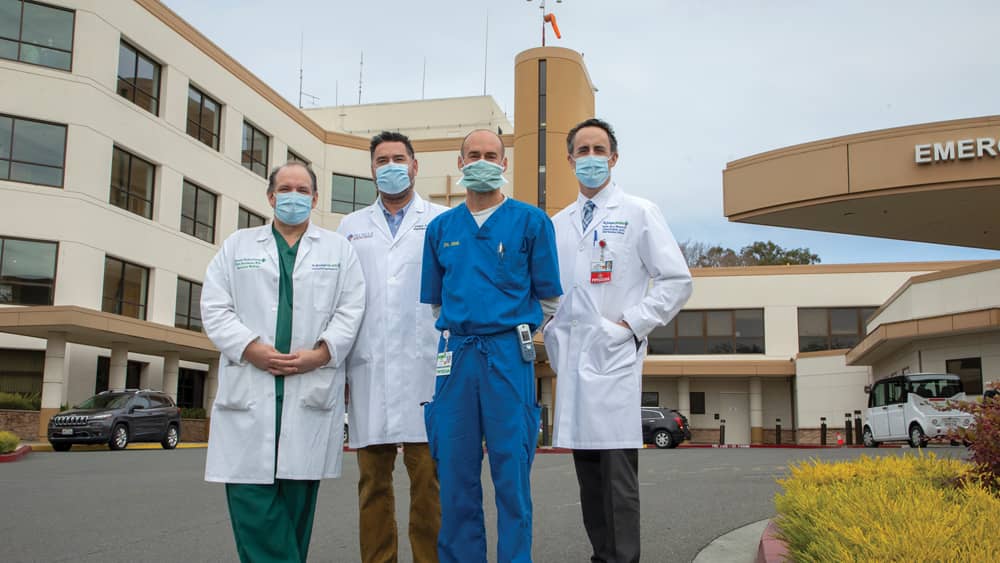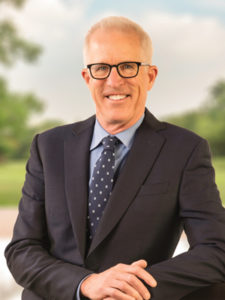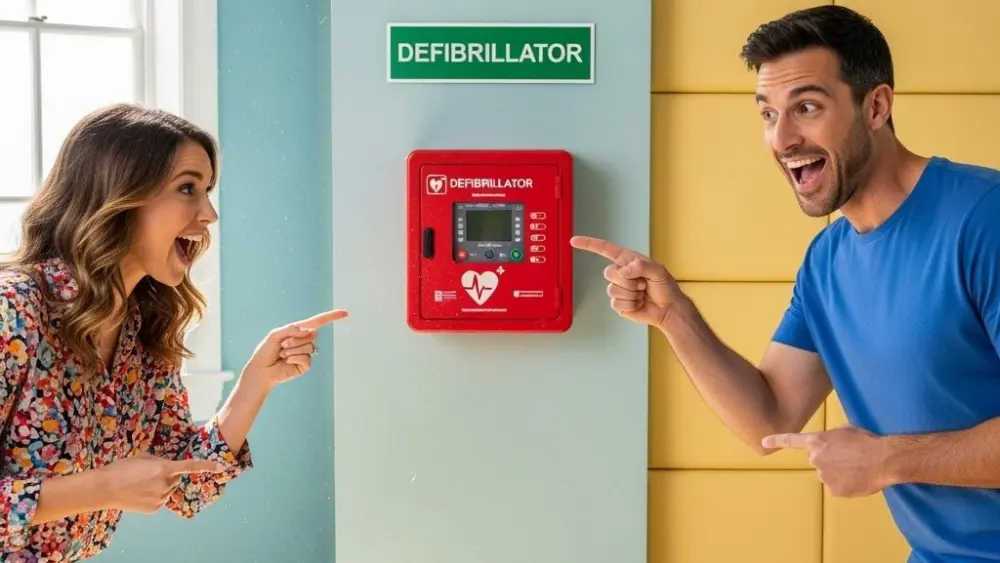
From left, Elliot Brandwene, M.D., emergency medical physician; Omar Ferrari, M.D., emergency medical physician; Kurt Holt, D.O., emergency medical specialist; Chad Krilich, M.D.. chief medical officer, Providence St. Joseph Health Sonoma County
The pandemic surge that slammed California in December seems to be waning. At that time, the state was reporting as many as 54,000 new cases of COVID-19 daily. By mid-January that number had fallen to 23,024. On Jan. 22, California had a one-day record of 764 deaths from COVID-19. Yet, the rates for new infections fell by more than 6,000 in one January week, and hospitalizations from COVID-19 dropped more than 10 percent over a two-week timeframe during that month.
With a new administration in power in Washington, D.C., and new wide-reaching policies being put into place to fight the pandemic, optimism rose significantly in late January that the pandemic might be brought under control sooner rather than later.
Regardless, it’s been a rough 12 months for California.
On March 4, 2020, Gov. Gavin Newsom declared a state of emergency, when 53 cases of coronavirus had been confirmed. A week later, he suggested that all gatherings of more than 250 people should be postponed or cancelled. Only days after that, he asked that all persons 65 and older isolate at home. By March 19, the governor had issued a shelter-in-place order for the entire state for an undetermined amount of time. Two weeks later, several Bay Area counties had extended those shelter orders into May. The orders and restrictions came so fast and furious that it was difficult to keep up, with each North Bay county following specific mandates imposed by their respective health officers.
North Bay hospitals and health-care systems have been pushed to the limit to safely provide care for COVID-19 patients over the past year, while also making certain patients who are admitted for other reasons are accommodated. They have faced countless challenges, not only to care for their virus patients, but to also take good care of their caregivers.
Inspirational frontline workers
Chad Krilich, M.D., chief medical officer for Providence St. Joseph Health Sonoma County, which operates Santa Rosa Memorial Hospital and affiliate Petaluma Valley Hospital (PVH) hospitals, rounds regularly on the COVID units at the two facilities. “Seeing what our COVID-19 teams are doing every day is truly inspiring. They are an amazing group,” he says.
Krilich goes on to list numerous ways in which the COVID-19 care teams are being looked after and supported. “There’s a lot being done to acknowledge that their work is difficult. This is in the spirit of helping our employees through a tough time for them. We conduct a monthly session where caregivers and medical staff are invited to care for patients, including our COVID-19 population. Caregivers and medical staff talk about how caring for COVID-19 patients impacts them, and they share their sorrows, joys and the stress they have endured during this pandemic.”
During the pandemic and wildfires, Providence offered financial and housing assistance to caregivers displaced by fire, as well as massages, meditation sessions, child-care resources, and on-site and virtual counseling sessions (in English and Spanish) with licensed therapists to help with stress relief.
Thanks to the generosity of local merchants and businesses, Providence also coordinated donations to caregivers of fresh flowers, to-go meals, gift baskets, wine and more. The creative expressions of community support for Providence caregivers also include sidewalk chalk drawings, balloon arches and neighborhood groups, who’ve gathered outside of hospitals in Santa Rosa and Petaluma to salute health professionals on the front lines of COVID-19 care. “Also, our larger Providence program of employee wellness assistance, called Choose Well, offers behavioral health support for anyone who wants it,” says Krilich.
“In those early weeks, nobody knew much about COVID, and though we had done a lot of preparation for the inevitability of it, just like anything you’ve not encountered before there was a little bit of anxiety among our care staff. But our people stepped right up and did the job.”—William Carroll, M.D., vice president of medical affairs, Sutter Santa Rosa Regional Hospital
Sutter Santa Rosa Regional Hospital’s vice president of medical affairs, William Carroll, M.D., appreciates how the local community has stepped up to support frontline workers in numerous ways. In addition to sidewalk chalk “Thank You” messages, many individuals and organizations donated meals and food to the care staff. “Our community wanted to help be a part of the solution, and those are great ways to say that they support our caregivers’ hard work.”

Sutter Santa Rosa admitted its first COVID-19 patient late in February 2020, says Carroll, and one of the most significant outcomes of the pandemic has been the level of comfort and competence the frontline staff now have over managing these patients. “In those early weeks, nobody knew much about COVID, and though we had done a lot of preparation for the inevitability of it, just like anything you’ve not encountered before there was a little bit of anxiety among our care staff. But our people stepped right up and did the job. Nobody said they wouldn’t take care of a COVID patient.”
Positive treatments, developments
One of the metrics Sutter evaluates daily is length of stay for a COVID patient—the time between being admitted to being discharged. “When we first started taking in COVID patients, their average length of stay was 17 days, and now it’s down to a little over seven days. Part of that improvement has to do with the new treatments that have come online, such as remdesivir, and we also can use steroid therapies where indicated. We try to avoid putting patients on ventilators or breathing machines because the outcomes for them tend to be worse.”
Another positive development this winter, says Carroll, is how little the flu season impacted the hospital. “We’ve had only a handful of flu patients needing to be hospitalized, and we believe that’s related partly to some of the infection prevention techniques to lessen the spread of COVID. The culture of wearing masks is keeping down the spread of the flu.”
As part of the Providence health system of 51 hospitals and numerous other medical facilities in several states, Krilich says Memorial and PVH have an abundance of institutional knowledge about COVID-19 to draw upon. As it happens, Providence Everett Hospital, located in Everett, Wash., was the first hospital in the United States to admit a patient with the coronavirus. The man is now fully recovered.
“When the next pandemic comes, and the history of medicine tells us that it will, we have an updated playbook for crisis planning so that we have super clear priorities and resources ready.”— Chad Krilich, M.D., medical director for Providence St. Joseph Health Sonoma County
Many such patients who are discharged to return home can be monitored remotely, says Krilich. “It depends on the patient’s clinical course, but in terms of using new technology, we not only discharge them with normal home health resources, but we now have the ability to monitor their oxygen and heart rate levels. These technologies have enabled us to discharge these patients earlier, which is much better for their recovery. It also means the hospital is using less personal protective equipment (PPE), which is a huge advantage.”
Generally speaking, PPE shortages have not been a problem for North Bay hospitals. “Our supply chain issues early on in the pandemic have been completely resolved,” says Carroll. “Locally, there might have been the chance of running low on masks or gowns, but being part of a large integrated system such as Sutter, we never ran out of what we needed. Initially, one of the things we most worried about was having enough N95 masks. We had plenty in stock for normal operations, but with COVID the situation became not normal.
“But even beyond PPE supplies, the value of being part of an integrated network has manifested itself in additional ways during the COVID crisis, such as leveraging the vast knowledge of infection prevention and intensive care experts. It’s been a huge team effort both locally and through the larger Sutter system.”
Having enough PPE on hand, says Krilich, will always be monitored carefully. “The supply chain has caught up with the demand, and we’re in a good place. We no longer need to launch campaigns to make masks. But there’s always something that can bubble up. For now, we are fortunate to have enough masks, gowns, face shields and gloves. Those are the big items.”
Ramping up telemedicine
The physician-in-chief for Kaiser Permanente Napa-Solano says that Kaiser had to take a hard look at the design flow in its hospitals and other facilities when the pandemic hit. “We had to figure out how many non-COVID patients who needed in-person care we could safely bring in at one time, and we asked ourselves, ‘Why make them wait?’ We decided [to] move patients directly into exam rooms, instead of leaving them sitting in a common waiting area with others,” explains Christopher Walker, M.D.
With in-person visits scaled back where possible, many doctors and patients have pivoted willingly to telemedicine for video chats. “Kaiser was fairly unique at the beginning of the COVID crisis because we’d already made extensive progress with digital communications, and we had that infrastructure set up for virtual visits,” says Walker. “The past year has forced us to create digital interfaces that are better for our patients, and our video technology has been significantly upgraded. It’s super easy even for our tech-challenged patients and has enabled us to keep these people at home if they don’t physically need to come in to the office. This has also helped us work with members who may have delayed care for some problems because of fear of COVID. Kaiser has always been great at upstream preventive care and catching health issues before they happen or become more serious.”
Krilich says that on the hospital side, they had advance warning of what was to come. “Early on, we knew we had to be prepared for a possible large surge of COVID-19 patients like in New York, and that was the push we needed to move forward more seriously on telemedicine,” says Krilich. “Some patients want or need an in-person visit, but some have also been grateful to not head into the office. Telemedicine is not going away anytime soon. It’s been a great resource for our patients and it continues to improve access to care.”

Supporting its frontline workers, and all of its staff members, is paramount to Kaiser, says Walker. “We’ve always been forward thinking in our wellness resources for employees, and well known for our nutrition and well-being programs, and our meditation and mindfulness resources. Part of our Employee Assistance Program is having psychologists on hand for those teams that are most deeply impacted caring for COVID patients.”
Walker’s background as a former military physician also makes him keenly aware of the consequences of post-traumatic stress disorder (PTSD). “We’ve made certain that we are set up for any employee who may be suffering PTSD. As I saw in the military setting, once people go home from difficult work and are off-duty, that’s when PTSD can hit them. We’re also sharing a lot of gratitude and positive affirmations with care staff, and our teams try to celebrate some of the good things that have come out of this crisis.”
Elective surgeries resume
At the beginning of the pandemic, most non-emergency or “elective” surgeries and procedures were postponed at hospitals statewide at the direction of the California Department of Public Health, says Carroll. “We didn’t know then if we would experience a New York-size surge in COVID cases, and so cancelling surgeries helped to preserve supplies of PPE. After the directive was lifted we eased back into performing these surgeries and procedures and we’re essentially back to normal in that way.”
Providence St. Joseph’s Krilich and Kaiser’s Walker concur that their hospitals have also resumed a normal schedule of elective surgeries and procedures. “But if our ICU volumes pick up, we will evaluate each of those electives on a case-by-case basis,” adds Krilich. “It’s a day-to-day evaluation. Memorial’s ICU has a tendency to be full in normal times anyway because we also accept transfers across Northern California.”
The backlog of electives that had been cancelled at his hospitals, says Walker, have all been completed. “We’ve taken care of everyone and we’re back doing electives full swing.”
The three hospital administrators interviewed for this article maintain that their health-care workers who wanted COVID vaccines have received them, with the second of the two shots expected to be completed by mid-February at the latest. The vaccine was approved for EUA (emergency use authorization) and that means health care workers can decline it. “Our frontline workers received the vaccine first at our acute care hospitals,” says Walker. “Initially some employees were hesitant, but once the first wave of workers got it, and we were all dancing up and down, most everyone else opted back in.”
By the end of January, says Krilich, 2,699 of the organization’s St. Joseph Sonoma County health-care workers had received their first dose of the vaccine, and 1,780 had received their second. Sutter and Kaiser chose to keep their numbers of vaccinated employees confidential.
The reality is, the health-care industry has a scare every year that it must be prepared for, according to Krilich. “We’ve had scares with Ebola and H1N1, but there hasn’t been anything that has impacted us before at this level. We drill and train regularly because there can be events like these. When the next pandemic comes, and the history of medicine tells us that it will, we have an updated playbook for crisis planning so that we have super clear priorities and resources ready.”
Calculating Safety
Amid the many raised eyebrows over Gov. Gavin Newsom’s lifting of stay-at-home orders statewide on Jan. 25, California’s chief health director was compelled to explain the math behind the decision that it was safe to do so.
Mark Ghaly, M.D., secretary of California Health and Human Services, presented a virtual news briefing on Jan. 26 that included a slide show revealing COVID-19 data for each region of the state. The figures included the weekly average of virus cases, transmission rate, hospitalizations, occupied ICU beds and other data used to determine future ICU capacity. He referred to the calculations as “a simple math formula.”
Following a surge in COVID-19 cases over the year-end holidays that strained ICUs, by Jan. 25, ICU capacity in the Bay Area had risen to more than 23 percent, with 25 percent capacity expected by mid-February, according to Ghaly.
He acknowledged that although deaths and hospitalizations caused by the pandemic remain high, the data as of late January reveal a steady downward trend. His calculations that hospitalizations dropped 20 percent in the last two weeks of January suggest that every person with the disease, on average, is infecting fewer than one other person.
Recovery and Resilience
Feel-good stories have been hard to come by over the past year, as COVID-19 has taken lives and left some of those who survive a serious case of the virus with long-term complications. But there have been countless positive outcomes and causes for small celebrations for patients and their caregivers, too.
In Sonoma County, one of the early hospitalized COVID-19 patients, named Jerry, spent nearly a month last spring in the ICU at Santa Rosa Memorial Hospital, and was eventually released on April 23. Nearly a year later, he’s doing well but living with a few health complications.
“Jerry was our first COVID-19 [patient] discharged from the hospital,” says Chad Krilich, M.D., chief medical officer, for Providence St. Joseph Health Sonoma County. “It was great to not only have our caregivers experience that success, but to also hear his story of recovery. The fact that Jerry received exceptional care from our team, well, we should all be proud of that achievement.”
A few months ago, a chemotherapy patient with Kaiser Permanente Napa-Solano was distraught that she couldn’t have any family members or friends with her during the treatments. Because most hospitals and health-care facilities have strictly prohibited non-patients from entering their buildings except in certain cases of childbirth or the passing of a family member, this cancer patient bonded with her treatment team in lieu of having loved ones sitting with her.
“The day of her last chemo treatment was a momentous occasion,” explains Dr. Christopher Walker, M.D., physician-in-chief for Kaiser Napa-Solano. “So in cahoots with the treatment staff and her family, her loved ones filled the parking lot outside a window where she could wave to them all. Physicians also came out to the parking lot, her treatment team and her large extended family of friends and neighbors. She was thrilled.”
Author
-

Jean Doppenberg is a lifelong journalist and the author of three guidebooks to Wine Country.
View all posts



